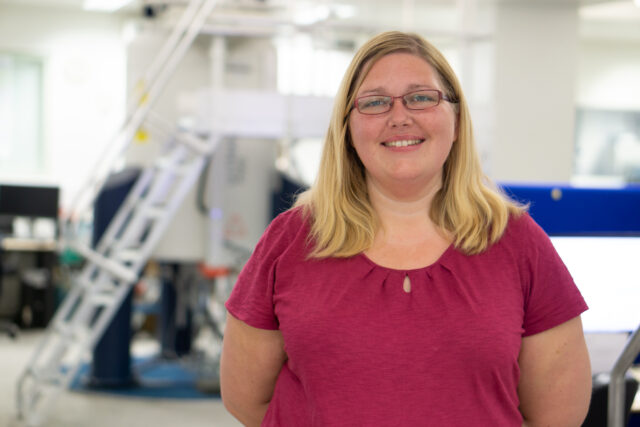Since her appointment as Somerville’s inaugural Dorothy Hodgkin Fellow in 2020, Dr Fay Probert has seen her research garner national headlines and industry partnerships. She joins us to explain the revolutionary diagnostic power of combining AI dataset analysis with Nuclear Magnetic Resonance spectroscopy.
This piece was originally published in the Somerville Magazine, 2022.

Dr Fay Probert, Somerville’s Dorothy Hodgkin Career Development Fellow
In a sense, my whole career has been guided by the search for interdisciplinary collaboration. As a maths undergrad, the projects that most fascinated me involved using complex mathematical methods to understand biological processes like viral infection.
This led me to do an MSc in mathematical biology and analytical chemistry. It was there I had my first encounter with Nuclear Magnetic Resonance (NMR) spectroscopy; I was completely blown away. NMR combines physics and chemistry to extraordinary effect, using purely quantum mechanical phenomena (an intrinsic property of the nucleus called ‘spin’) to provide structural and dynamic information about chemicals in exquisite detail. Following my first brush with NMR, I knew I had to do a PhD in that field – which led in turn to my current specialism in metabolomics, the scientific study of chemical processes involving the small molecule substrates, intermediates and products of cell metabolism called metabolites.
NMR is highly versatile: it can determine molecular structures, test drug kinetics, even evaluate food safety. But the function we rely on is NMR’s capacity to analyse complex mixtures with just a single experiment. This means we take a small amount of blood or another biofluid and, in just a few minutes, create ‘biomarker constellations’ that tell us a huge amount of chemical information about the metabolites present in the sample. We then use machine-learning algorithms (many of which I write – calling on my aforementioned love of maths!) to pick out the metabolite signals that indicate specific conditions or disease progression.
This multi-marker approach holds many advantages over traditional blood tests, which can only measure one marker at a time. An increase in one metabolite alone may not give sufficient accuracy for a diagnostic test, but an increase in metabolite ‘A’ coupled with a simultaneous decrease in metabolites ‘B’ and ‘C’ gives a holistic picture that vastly improves diagnostic accuracy.
Continuing Dorothy Hodgkin’s legacy: Dr Probert in the lab with the axion machine used in her research. Photo: Jack Evans
The Axinon IVD System which Dr Probert uses for her research
The Axinon IVD System was developed by German firm numbers AG
A scene from the lab
This test will give doctors an affordable way of empowering their diagnostic process, offering patients longer, better lives.
The test has been proven to have value across multiple conditions, but I work most closely on its use in diagnosing Multiple Sclerosis. At present, the greatest challenge clinicians face with MS is detecting the transition of the condition from the first phase of the disease (Rapidly Relapsing Multiple Sclerosis) to the more debilitating second phase of the disease (Secondary Progressive Multiple Sclerosis). Worsening of disability can be due to an attack or the first signs of progression. There is currently no biofluid test to determine whether someone has transitioned to SPMS and confirming this diagnosis can take years as clinicians have little choice but to wait and see if disability continues to progress.
Using NMR, we are able to identify the transition from RRMS to SPMS with 91% accuracy. We can also use the same test to identify acute relapses, predict relapses and even monitor response to treatments – all of which offers significant dividends in patient prognosis and quality of life. The clear value of this test in treating MS has led to a partnership with the German diagnostics firm numares AG. But the uses for multi-marker testing don’t stop with MS.
Interdisciplinary collaboration is not just helpful in science, it’s fundamental.
DR FAY PROBERT
Earlier this year, our research made national headlines because multi-marker testing has been proven effective in the early diagnosis of cancer. At present, patients suffering non-specific cancer symptoms such as weight loss and fatigue pose a challenge to GPs because there is no indication of tumour location. This means GPs must, as with MS, adopt a watch-and-wait approach until a specific symptom presents – risking serious adverse consequences given the connection between early detection and survival.
Using the methods we pioneered in the laboratory of Somerville’s Medical Fellow Professor Anthony, my colleagues have not only detected cancer in patients presenting with non-specific symptoms, but also whether that cancer has metastasised. We also believe that, with more work, the test could determine tumour location and what type of cancer it is – which has in turn generated further interest in commercialisation.
From here, the horizons are endless. We are now applying our work to a wide range of chronic diseases, ranging from rheumatoid arthritis to Alzheimer’s, epilepsy to migraines, even psychosis and depression – and the early results are promising.
The last point I want to make is that none of this happened in isolation. Throughout our research, we’ve consulted closely with clinicians, learning where they most need additional support to improve diagnosis and make better treatment decisions. My greatest hope – and I think this is true of everyone both at my newly formed laboratory and that of Professor Anthony – is that this test will offer doctors a fast, affordable and effective means of empowering their diagnostic process. That, in turn, will improve their ability to create personalized care pathway, offering patients longer, better lives.
It also affirms what I felt all those years ago, when I first started thinking about combining maths and biology. Interdisciplinary collaboration is not just helpful in science, it’s fundamental.